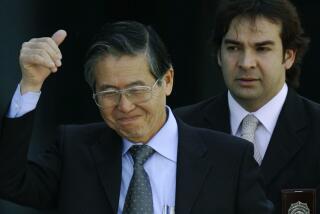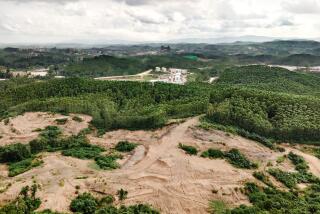Ruled amid prosperity, slaughter
JAKARTA, INDONESIA — Former President Suharto, an army general who rose to power in Indonesia with the slaughter of hundreds of thousands of people and ruled for 32 years over an era of rapid economic growth and extraordinary graft, died Sunday in Indonesia. He was 86.
Like many Javanese, Suharto went by only one name. He had been in poor health for years after suffering several strokes and other ailments. He was rushed to the hospital Jan. 4 with anemia, low blood pressure and other ailments.
Suharto’s unyielding opposition to communism won him the backing of the United States during the height of the Cold War, although he was one of the most brutal and corrupt rulers of that era. He governed the world’s fourth-most-populous nation with a combination of paternalism and ruthlessness from 1965 until he was ousted in the spring of 1998.
Pallbearers, dressed in combat fatigues and representing each of Indonesia’s armed forces, carried Suharto’s flag-draped coffin after a ceremony Monday morning at Cendana Palace, where he lived as president and in retirement.
Female relatives sprinkled the ground with flower petals after Suharto’s coffin was loaded into a white Mercedes-Benz van.
“We ask that if he had any faults, please forgive them . . . may he be absolved of all his mistakes,” Suharto’s eldest daughter, Siti Hardiyanti Rukmana, told reporters earlier.
Her father’s coffin was flown by transport plane to Central Java, where President Susilo Bambang Yudhoyono presided over a state funeral and burial at the Suharto family cemetery near Solo. He was laid to rest next to his wife.
Hailing the former dictator as “one of the nation’s best citizens,” Yudhoyono declared a week of national mourning.
Hundreds of Indonesians converged on Suharto’s mansion in south Jakarta, and their mixed reactions to his death reflected the complex legacy of a man revered by many as the “Father of Development” and despised by many others as a mass murderer.
Siti Rahayu, a 27-year-old housemaid, said she was sad because Suharto had suffered for weeks, and she missed his regime because things were better for the poor then.
“Although he’s responsible for all the corruption, collusion and nepotism, it was for the people. We had a lot of debt because he wanted to build our country,” she said.
Rudiyanto, 43, a wildlife researcher, said Suharto was still synonymous with president in his mind.
“And as president, Suharto did what he had to; whether his way of doing it required ‘victims,’ that’s another story,” Rudiyanto said, adding that it’s important for the country’s future that the courts decide whether “he was wrong or right, whether he was hero or crook.”
U.S. Ambassador Cameron R. Hume paid his respects to Suharto at the former dictator’s home. In a statement, Hume praised the “remarkable economic and social development” that Indonesia achieved under Suharto.
“Though there may be some controversy over his legacy, President Suharto was a historic figure who left a lasting imprint on Indonesia and the region of Southeast Asia,” Hume said.
Suharto expanded Indonesia’s territory by force and guile, annexing the territories of Papua and East Timor and brutally suppressing the independence movement in the province of Aceh in a conflict that lasted 27 years.
The estimates of the number of people killed by Suharto’s regime “vary from 300,000 to 2 million, but the exact number nobody knows,” said Asmara Nababan, former secretary general of Indonesia’s Human Rights Commission. “It created a big wound in society, and even today it is not completely gone.”
His military regime incarcerated hundreds of thousands of political prisoners for years without trial. Many critics of his rule simply vanished.
But long before Suharto’s death, Indonesians were working to build a democracy from the rubble of his regime, which collapsed in 1998 amid nationwide protests and riots sparked by an economic meltdown across the region.
Under a carefully managed compromise, the Indonesian military retained its dominance over politics behind the scenes in exchange for allowing democratic reforms.
In one of the most significant steps of the post-Suharto era, government power has been decentralized. More than 16,000 public service facilities were transferred to regional authorities, which boosted economic growth in areas that once seemed to be overlooked.
Conflicts in East Timor and Aceh have been resolved. East Timor was granted independence, while guerrillas in Aceh laid down their arms in exchange for special autonomy for the province, a peace deal forged after the devastation of the 2004 tsunami.
After Suharto’s ouster, Indonesia’s radical Islamic movement gained new strength, but the Democratic government’s softer approach has slowly shown results. There have been fewer high-profile attacks in recent years.
Suharto preferred to rule with an iron fist. He not only crushed Indonesia’s Communist Party, but also suppressed Islamic extremists, forcing the most militant clerics into exile.
During this 32-year rule, Suharto is credited with stimulating economic growth, cutting the annual inflation rate from 600% to 6.5% and raising personal income from an average of $70 a year to $1,300. The number of Indonesians living in dire poverty fell from 56% to 12%, and literacy rates and average life spans rose.
At the same time, he divided the nation’s wealth among his six children and his cronies, amassing a family fortune estimated at $40 billion. The system of government by kleptocracy that flourished under Suharto has plagued the country ever since.
Suharto’s son, Hutomo “Tommy” Mandala Putra, was sent to prison for embezzling millions and orchestrating the murder of a Supreme Court justice, but Suharto was never prosecuted. Nor did the government ever seize his allegedly ill-gotten assets.
In 2000, the government charged him with embezzling $571 million. But the courts eventually ruled that Suharto, who had suffered strokes after resigning the presidency, was too ill to face charges.
In May 2006, Yudhoyono’s government reviewed the charges against Suharto and reached the same conclusion as the judges: He was too ill to be taken to court.
Indonesia’s attorney general said this month that he would pursue only civil claims against seven Suharto family foundations and offered to settle out of court for $1.5 billion. The family rejected the offer.
Unlike other dictators who stashed assets in foreign bank accounts, Suharto maintained that he never diverted money overseas.
“The fact is I don’t even have 1 cent of savings abroad, don’t have accounts at foreign banks, don’t have deposits abroad and don’t even have any shares in foreign firms,” he said in one of his few public statements after he lost power -- a recorded message played in September 1998 on a television station partly owned by his oldest daughter.
Suharto lived out his retirement on a leafy street in Jakarta, the capital, occasionally meeting with dignitaries who came to visit.
Suharto was born June 8, 1921, in Kemusu, a village in central Java, the only child of parents who divorced shortly after he was born.
The future president’s family was so poor that it could not afford to buy him the shorts and shoes required at his junior high school, forcing him to quit. He later finished his formal education at 18 in a school run by Muhammadiyah, an Islamic organization.
With the departure of Japanese forces after World War II, Suharto joined the fight against the Dutch rulers. Indonesia declared independence in 1945, and he rose through the ranks of the army.
Independent Indonesia’s first president was Sukarno, a nationalist who had been imprisoned by the Dutch in 1929 and 1937. In 1964, Sukarno told the United States to “go to hell with your aid.” The next year, he pulled Indonesia out of the United Nations.
In October 1965, dissident army units abducted and killed six of Sukarno’s top generals. For reasons never fully explained, Suharto was not among the victims, although he was a major general and key army leader. Many observers speculated that he was involved in the abortive coup, which officially was blamed on the Communists. Yet it was Suharto who took the initiative and crushed the revolt.
He then outmaneuvered Sukarno and placed him under virtual house arrest from 1966 until his death in 1970 at 69.
Appointed acting president in 1967, Suharto moved to consolidate his newfound power with a program called the New Order. He cleared the military and civil service of leftists in a bloody purge that won him the support of U.S. leaders.
The annexation and military occupation of Papua in 1969 after a rigged vote of self-determination and of East Timor in 1975 led to hundreds of thousands more deaths. East Timor, after struggling against Indonesian rule for 24 years, won its independence in 1999 after Suharto was ousted.
Teten Masduki, coordinator of Indonesia Corruption Watch, said Suharto plundered Indonesia’s forests, mineral resources, oil and agriculture. He set trade policies to benefit his financial empire, gave his cronies control of the banks and sold off the country’s assets.
By 1997, Indonesia’s economy was too fragile to survive the region’s economic collapse.
Small demonstrations by students started in February 1998 with a call for economic and political reform. The protests grew, attracting professionals and academics. The shooting of six students by security forces in Jakarta on May 12, 1998, sparked riots that claimed 500 lives. Nine days later, Suharto announced his resignation and handed over power to Vice President Bacharuddin Jusuf Habibie.
Suharto at that point had ruled Indonesia for more than half the country’s existence and had been in power longer than any sitting head of state except Cuba’s Fidel Castro.
Many critics were disappointed he was never put on trial. The government’s inability to hold Suharto accountable, they said, set back Indonesia’s recovery from three decades of authoritarian rule.
Suharto’s wife, Siti Hartinah, died in 1996. Suharto is survived by three sons and three daughters.
richard.paddock@ latimes.com
Times staff writer Dinda Jouhana and former Times staff writer David Lamb contributed to this report.
More to Read
Sign up for Essential California
The most important California stories and recommendations in your inbox every morning.
You may occasionally receive promotional content from the Los Angeles Times.










